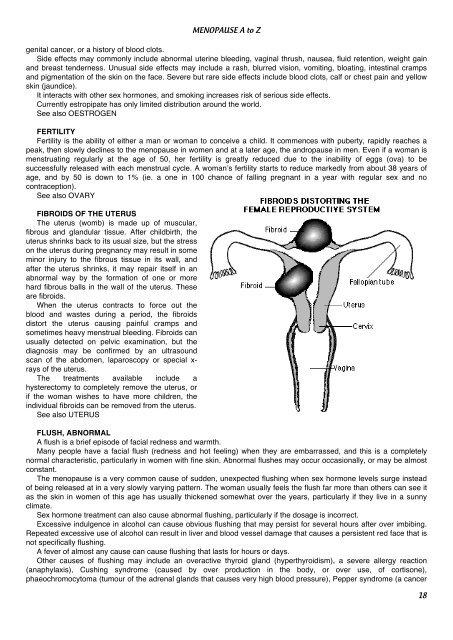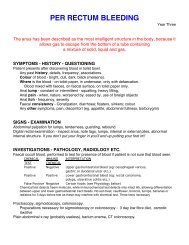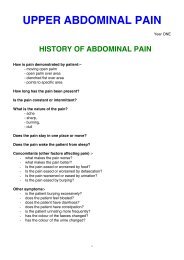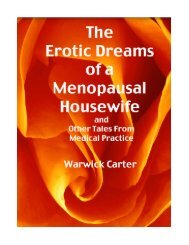Menopause A to Z.pdf - Medwords.com.au
Menopause A to Z.pdf - Medwords.com.au
Menopause A to Z.pdf - Medwords.com.au
You also want an ePaper? Increase the reach of your titles
YUMPU automatically turns print PDFs into web optimized ePapers that Google loves.
MENOPAUSE A <strong>to</strong> Z<br />
genital cancer, or a his<strong>to</strong>ry of blood clots.<br />
Side effects may <strong>com</strong>monly include abnormal uterine bleeding, vaginal thrush, n<strong>au</strong>sea, fluid retention, weight gain<br />
and breast tenderness. Unusual side effects may include a rash, blurred vision, vomiting, bloating, intestinal cramps<br />
and pigmentation of the skin on the face. Severe but rare side effects include blood clots, calf or chest pain and yellow<br />
skin (j<strong>au</strong>ndice).<br />
It interacts with other sex hormones, and smoking increases risk of serious side effects.<br />
Currently estropipate has only limited distribution around the world.<br />
See also OESTROGEN<br />
FERTILITY<br />
Fertility is the ability of either a man or woman <strong>to</strong> conceive a child. It <strong>com</strong>mences with puberty, rapidly reaches a<br />
peak, then slowly declines <strong>to</strong> the menop<strong>au</strong>se in women and at a later age, the androp<strong>au</strong>se in men. Even if a woman is<br />
menstruating regularly at the age of 50, her fertility is greatly reduced due <strong>to</strong> the inability of eggs (ova) <strong>to</strong> be<br />
successfully released with each menstrual cycle. A woman’s fertility starts <strong>to</strong> reduce markedly from about 38 years of<br />
age, and by 50 is down <strong>to</strong> 1% (ie. a one in 100 chance of falling pregnant in a year with regular sex and no<br />
contraception).<br />
See also OVARY<br />
FIBROIDS OF THE UTERUS<br />
The uterus (womb) is made up of muscular,<br />
fibrous and glandular tissue. After childbirth, the<br />
uterus shrinks back <strong>to</strong> its usual size, but the stress<br />
on the uterus during pregnancy may result in some<br />
minor injury <strong>to</strong> the fibrous tissue in its wall, and<br />
after the uterus shrinks, it may repair itself in an<br />
abnormal way by the formation of one or more<br />
hard fibrous balls in the wall of the uterus. These<br />
are fibroids.<br />
When the uterus contracts <strong>to</strong> force out the<br />
blood and wastes during a period, the fibroids<br />
dis<strong>to</strong>rt the uterus c<strong>au</strong>sing painful cramps and<br />
sometimes heavy menstrual bleeding. Fibroids can<br />
usually detected on pelvic examination, but the<br />
diagnosis may be confirmed by an ultrasound<br />
scan of the abdomen, laparoscopy or special x-<br />
rays of the uterus.<br />
The treatments available include a<br />
hysterec<strong>to</strong>my <strong>to</strong> <strong>com</strong>pletely remove the uterus, or<br />
if the woman wishes <strong>to</strong> have more children, the<br />
individual fibroids can be removed from the uterus.<br />
See also UTERUS<br />
FLUSH, ABNORMAL<br />
A flush is a brief episode of facial redness and warmth.<br />
Many people have a facial flush (redness and hot feeling) when they are embarrassed, and this is a <strong>com</strong>pletely<br />
normal characteristic, particularly in women with fine skin. Abnormal flushes may occur occasionally, or may be almost<br />
constant.<br />
The menop<strong>au</strong>se is a very <strong>com</strong>mon c<strong>au</strong>se of sudden, unexpected flushing when sex hormone levels surge instead<br />
of being released at in a very slowly varying pattern. The woman usually feels the flush far more than others can see it<br />
as the skin in women of this age has usually thickened somewhat over the years, particularly if they live in a sunny<br />
climate.<br />
Sex hormone treatment can also c<strong>au</strong>se abnormal flushing, particularly if the dosage is incorrect.<br />
Excessive indulgence in alcohol can c<strong>au</strong>se obvious flushing that may persist for several hours after over imbibing.<br />
Repeated excessive use of alcohol can result in liver and blood vessel damage that c<strong>au</strong>ses a persistent red face that is<br />
not specifically flushing.<br />
A fever of almost any c<strong>au</strong>se can c<strong>au</strong>se flushing that lasts for hours or days.<br />
Other c<strong>au</strong>ses of flushing may include an overactive thyroid gland (hyperthyroidism), a severe allergy reaction<br />
(anaphylaxis), Cushing syndrome (c<strong>au</strong>sed by over production in the body, or over use, of cortisone),<br />
phaeochromocy<strong>to</strong>ma (tumour of the adrenal glands that c<strong>au</strong>ses very high blood pressure), Pepper syndrome (a cancer<br />
18









